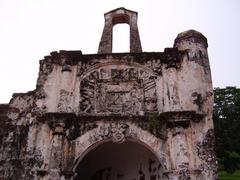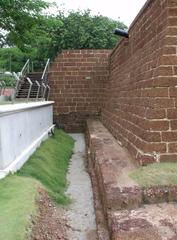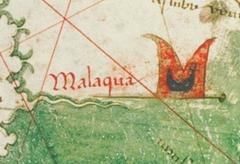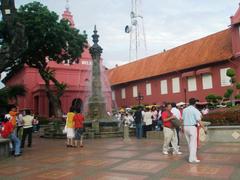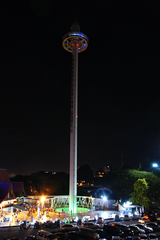Comprehensive Guide to Visiting Tanjung Kling, Malaysia
Date: 16/08/2024
Introduction
Tanjung Kling, nestled in the Central Melaka District of Malaysia, stands as a testament to the country’s rich historical and cultural tapestry. Known for its strategic coastal location, Tanjung Kling has been a melting pot of cultures, attracting traders from China, India, the Middle East, and beyond during the era of the Malay Sultanate. This confluence of cultures is encapsulated in the town’s name, derived from ‘Kling,’ historically referring to people from the Indian subcontinent. Today, Tanjung Kling offers a unique blend of historical landmarks, architectural marvels, and cultural diversity, making it an intriguing destination for travelers. From the Kampung Kling Mosque, a remarkable fusion of Sumatran, Chinese, Hindu, and Malacca Malay architectural styles, to the serene Puteri Beach, Tanjung Kling is a microcosm of Malaysia’s multifaceted heritage and natural beauty. This guide provides an in-depth exploration of Tanjung Kling’s history, cultural significance, and practical travel information, ensuring a comprehensive travel experience (source).
Table of Contents
- [Introduction](#introductionintroduction)
- [Historical Background](#historical-backgroundhistorical-background)
- [Architectural Heritage](#architectural-heritagearchitectural-heritage)
- [Cultural Significance](#cultural-significancecultural-significance)
- [Economic Activities](#economic-activitieseconomic-activities)
- [Tourism and Modern Developments](#tourism-and-modern-developmentstourism-and-modern-developments)
- [Environmental and Social Challenges](#environmental-and-social-challengesenvironmental-and-social-challenges)
- [Community and Cultural Preservation](#community-and-cultural-preservationcommunity-and-cultural-preservation)
- [Visitor Information](#visitor-informationvisitor-information)
- [Nearby Attractions](#nearby-attractionsnearby-attractions)
- [Special Events and Guided Tours](#special-events-and-guided-toursspecial-events-and-guided-tours)
- [Best Time to Visit](#best-time-to-visitbest-time-to-visit)
- [Accommodation Options](#accommodation-optionsaccommodation-options)
- [Dining Recommendations](#dining-recommendationsdining-recommendations)
- [Transportation](#transportationtransportation)
- [Activities and Attractions](#activities-and-attractionsactivities-and-attractions)
- [Cultural Etiquette](#cultural-etiquettecultural-etiquette)
- [Safety Tips](#safety-tipssafety-tips)
- [Local Events and Festivals](#local-events-and-festivalslocal-events-and-festivals)
- [Budgeting Tips](#budgeting-tipsbudgeting-tips)
- [Environmental Responsibility](#environmental-responsibilityenvironmental-responsibility)
- [FAQ](#faqfaq)
- [Conclusion](#conclusionconclusion)
Historical Background
Tanjung Kling, located in the Central Melaka District of Malaysia, has a rich historical tapestry that dates back to the era of the Malay Sultanate. The town’s name, Tanjung Kling, is derived from the term “Kling,” which historically referred to people from the Indian subcontinent, particularly South Indians. This nomenclature reflects the area’s historical significance as a melting pot of cultures and a bustling trading center during the Malay Sultanate period. During the colonial era, Tanjung Kling was a prominent trading hub, especially under Portuguese rule. The Portuguese influence is still evident in some of the architectural styles and cultural practices in the area. The town’s strategic coastal location made it an ideal spot for trade and commerce, attracting traders from various parts of the world, including China, India, and the Middle East.
Architectural Heritage
One of the most significant historical structures in Tanjung Kling is the Kampung Kling Mosque. Originally built in 1748 by Indian Muslim traders, the mosque’s architecture is a unique blend of Sumatran, Chinese, Hindu, and Malacca Malay influences. The mosque’s original wooden structure was later rebuilt using bricks, and it retains much of its original architectural design, making it a vital cultural and historical landmark (source).
Cultural Significance
Tanjung Kling is a microcosm of Malaysia’s multicultural heritage. The town is home to several religious sites, including Buddhist temples and mosques, reflecting the diverse religious practices of its inhabitants. The Kampung Kling Mosque, located on Jalan Tukang Emas (also known as Harmony Street), is particularly noteworthy. This street is famous for its religious harmony, housing various religious structures such as the Sri Poyatha Moorthi Temple and Cheng Hoon Teng Temple, alongside the mosque (source).
Economic Activities
Historically, the primary economic activities in Tanjung Kling revolved around fishing and trade. The town’s coastal location provided ample opportunities for fishing, which remains a significant livelihood for many residents. In recent years, the local economy has diversified to include tourism and the rental of accommodation facilities. The development of new apartment complexes with sea-facing views has also contributed to the local economy, although it has impacted the traditional fishing industry and the natural beauty of the coastline (source).
Tourism and Modern Developments
Tanjung Kling’s tourism value has evolved over the years. The town is known for its beautiful beaches, such as Puteri Beach, which is particularly stunning during sunrise and sunset. However, recent land reclamation and construction activities have altered the natural landscape, affecting the town’s tourism appeal. Despite these changes, Tanjung Kling remains a hidden gem for tourists seeking a quieter, less commercialized destination in Malaysia (source).
Environmental and Social Challenges
The rapid development in Tanjung Kling has not been without its challenges. The construction of new apartment complexes and land reclamation activities have led to environmental concerns, particularly affecting the local fishing industry. The state government has implemented measures to address these issues, including requiring environmental impact assessments (EIA) for land reclamation projects. These measures aim to balance development with the preservation of the town’s natural and cultural heritage (source).
Community and Cultural Preservation
The local community in Tanjung Kling is known for its close-knit nature and cultural richness. The town’s residents have a deep connection to their heritage, as evidenced by the preservation of historical sites and traditional practices. For instance, the worship of the Sea Goddess, Mazu, at the local Chinese temple highlights the town’s cultural diversity and the residents’ efforts to maintain their ancestral traditions (source).
Visitor Information
Visiting Hours: Most historical sites and attractions in Tanjung Kling are open from 9:00 AM to 6:00 PM daily. It is advisable to check specific visiting hours for each site as they may vary.
Ticket Prices: Entry to many sites is free, but some attractions may have a nominal fee. For example, the Kampung Kling Mosque does not charge an entry fee, but donations are welcome.
Travel Tips: The best time to visit Tanjung Kling is during the dry season, from April to October. Visitors are encouraged to dress modestly when visiting religious sites and to respect local customs and traditions.
Nearby Attractions
- Melaka Sultanate Palace Museum: A replica of the palace of the Melaka Sultanate, showcasing historical artifacts and exhibits.
- Jonker Street: Famous for its vibrant night market, offering a variety of local foods, souvenirs, and antiques.
- A Famosa: The remains of a Portuguese fort, one of the oldest surviving European architectural remains in Southeast Asia.
Special Events and Guided Tours
Tanjung Kling hosts several cultural events throughout the year, celebrating its diverse heritage. Guided tours are available and provide in-depth insights into the town’s history and cultural landmarks. Tourists can also enjoy photographic spots like Puteri Beach, which offers breathtaking views, especially at sunrise and sunset.
Best Time to Visit
Tanjung Kling enjoys a tropical climate with relatively stable temperatures throughout the year, averaging around 82°F (28°C). The best time to visit is during the dry season, from March to June, when the weather is more predictable and conducive to outdoor activities (source). This period also coincides with the shoulder season, offering fewer crowds and better hotel rates (source).
Accommodation Options
Tanjung Kling offers a variety of accommodation options to suit different budgets and preferences. For families, the Mutiara Melaka Beach Resort is a kid-friendly homestay featuring a minimalist Muji style, modern amenities, and family-friendly facilities such as a safe swimming pool and playground (source). For those seeking a more luxurious experience, the Melaka Beachfront Villa with Pool offers stunning views and direct beach access.
Dining Recommendations
Food is an integral part of the Tanjung Kling experience. One must-try dish is Asam Pedas, a traditional Malaccan cuisine known for its spicy and tangy flavors. Asam Pedas Al-Fateh is a popular spot where you can enjoy various versions of this dish, along with Nasi Campur, another local favorite (source). For a romantic dining experience, consider outdoor beach dining at Lot 2251, Jalan Tanjung Kling, which offers a perfect sunset view and a romantic ambiance (source).
Transportation
Getting around Tanjung Kling is relatively straightforward. Public transportation options include buses and taxis, but renting a car can offer more flexibility, especially if you plan to explore the surrounding areas. For those who prefer not to drive, ride-sharing services like Grab are also available.
Activities and Attractions
- Melaka Straits Mosque: This floating mosque is an architectural marvel and offers stunning views, especially at sunset (source).
- Melaka River Cruise: A relaxing way to explore the historical city of Malacca, offering picturesque views of colonial buildings and street art (source).
- Jonker Walk Melaka: A bustling street market known for its antiques, textiles, and delicious street food (source).
- A’Famosa: A historical fortress that offers a glimpse into Malacca’s colonial past (source).
Cultural Etiquette
Malaysia is a multicultural country with a rich blend of Malay, Chinese, and Indian cultures. When visiting Tanjung Kling, it’s essential to respect local customs and traditions. Here are some tips:
- Dress Modestly: While beachwear is acceptable at the beach, it’s advisable to dress modestly when visiting religious sites or local markets.
- Remove Shoes: Always remove your shoes before entering homes or religious sites.
- Use Right Hand: When giving or receiving items, use your right hand as the left hand is considered unclean.
Safety Tips
Tanjung Kling is generally a safe destination, but it’s always wise to take standard precautions:
- Stay Hydrated: The tropical climate can be quite humid, so make sure to drink plenty of water.
- Secure Belongings: While crime rates are low, it’s advisable to keep your belongings secure, especially in crowded areas.
- Health Precautions: Carry basic medications and insect repellent, as mosquitoes can be prevalent in tropical climates.
Local Events and Festivals
Visiting during local festivals can add a unique dimension to your trip. Some notable events include:
- Thaipusam: A Hindu festival celebrated in January or February, featuring elaborate processions and rituals (source).
- George Town Festival: Although not in Tanjung Kling, this cultural festival in Penang is worth a visit if you’re in Malaysia during July (source).
Budgeting Tips
Tanjung Kling offers a range of experiences that cater to different budgets. Here are some tips to make the most of your trip without breaking the bank:
- Affordable Dining: Local eateries and street food stalls offer delicious meals at reasonable prices. Expect to spend around RM10-RM20 per person at local spots like Asam Pedas Al-Fateh (source).
- Public Transport: Utilize public transportation or ride-sharing services to save on travel costs.
- Free Attractions: Many of Tanjung Kling’s attractions, such as the Melaka Straits Mosque and Jonker Walk, are free to visit.
Environmental Responsibility
As a responsible traveler, it’s essential to minimize your environmental impact. Here are some tips:
- Reduce Plastic Use: Carry a reusable water bottle and shopping bag.
- Respect Nature: Stick to designated paths and avoid disturbing wildlife.
- Support Local: Choose eco-friendly accommodations and support local businesses.
FAQ
Q: What are the visiting hours for Tanjung Kling?
Most attractions in Tanjung Kling, such as the Melaka Straits Mosque, are open from 9 AM to 6 PM. It’s advisable to check individual attraction websites for specific hours.
Q: Is there an entrance fee for Tanjung Kling?
While many attractions like Jonker Walk are free, other sites may have nominal entrance fees. Always check ahead to plan your visit accordingly.
Q: What are the best activities in Tanjung Kling?
Top activities include visiting the Melaka Straits Mosque, taking a Melaka River Cruise, exploring Jonker Walk, and touring the historical A’Famosa fortress.
Call to Action
Discover the rich history and cultural heritage of Tanjung Kling by planning your visit today. For more travel tips and updates, download the Audiala mobile app, check out other related posts, and follow us on social media.
References
- Softskills. (n.d.). Kampung Tanjung Kling - Melaka. source
- Triphobo. (n.d.). Things to do in Tanjung Kling. source
- Trip.com. (n.d.). Moments in Tanjung Kling. source
- The Poor Traveler. (2012). Kampung Kling Mosque, Malacca, Malaysia. source
- Audiala. (n.d.). Proclamation of Independence Memorial. source
